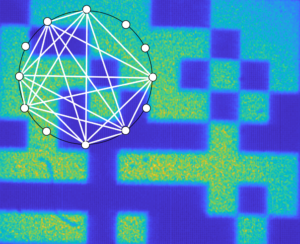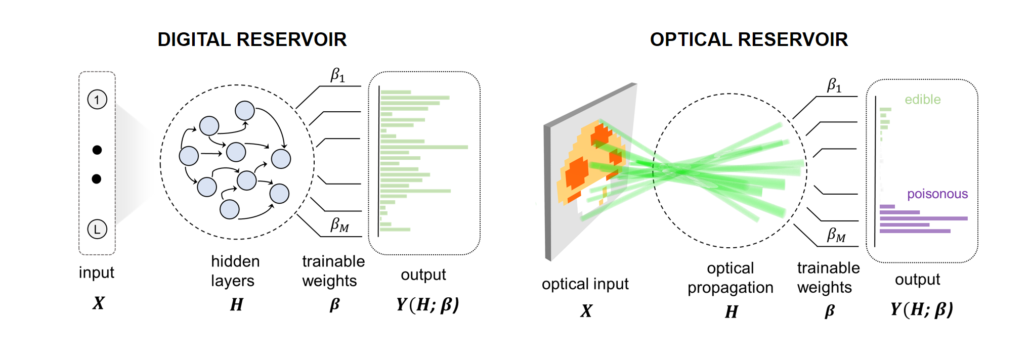OPTICAL COMPUTING EXPLAINED THROUGH THREE SIMPLE APPLICATIONS
Ising Machines
Combinatorial optimization problems are crucial for widespread applications but remain difficult to solve on a large scale with conventional hardware. The challenge motivates an intense search for specific computing devices that takes advantage of quantum features, nonlinear dynamics, or photonics. Ising machines are a class  of unconventional processors designed for finding the ground state of a Ising spin model. These computing machines are currently attracting broad attention since tasks such as partitioning, routing, and encrypting can be mapped on Ising Hamiltonians. We have proposed and demonstrated the use of spatial light modulation for encoding and processing large-scale spin systems. This allow us to realize the largest photonic Ising machine. Our optical platform is able to simulate spin problems with programmable couplings by implementing classical and quantum optimization algorithms. Our approach provides a general route toward large-scale computing that exploits speed, parallelism, and coherence of light.
of unconventional processors designed for finding the ground state of a Ising spin model. These computing machines are currently attracting broad attention since tasks such as partitioning, routing, and encrypting can be mapped on Ising Hamiltonians. We have proposed and demonstrated the use of spatial light modulation for encoding and processing large-scale spin systems. This allow us to realize the largest photonic Ising machine. Our optical platform is able to simulate spin problems with programmable couplings by implementing classical and quantum optimization algorithms. Our approach provides a general route toward large-scale computing that exploits speed, parallelism, and coherence of light.
- Pierangeli, G. Marcucci, and C. Conti, Large-Scale Photonic Ising Machine by Spatial Light Modulation, Phys. Rev. Lett. 122, 213902 (2019).
- Roques-Carmes, and M. Soljačić, “Photonic Ising machines go big” Physics 12, 2019.
- Pierangeli, G. Marcucci and C. Conti, Optical Ising machines solve complex engineering, science, and even business problems, Laser Focus World 55, 34 (2019).
- Pierangeli, G. Marcucci, D. Brunner, and C. Conti, Noise-enhanced spatial-photonic Ising machine, Nanophotonics 9, 4109 (2020).
- Pierangeli, G. Marcucci, and C. Conti, Adiabatic evolution on a spatial-photonic Ising machine, Optica 7, 1535 (2020).
- Pierangeli, M. Rafayelyan, C. Conti, S. Gigan, Scalable Spin-Glass Optical Simulator, Phys. Rev. Appl. 15, 034087 (2021).
Neuromorphic computing
Machine learning has emerged as an exceptional computational tool with applications in science, engineering, and beyond. Artificial neural networks are adept at learning from data to perform regression, classification, prediction, and generation. However, as data information content increases, optimizing a neural network is an energy-consuming process that requires extensive computational resources.
A promising idea to improve the efficiency of neural networks is to mimic biological nervous systems that utilize waves—as opposed to digital bits—to process information. This so-called neuromorphic computing is currently being developed for fast and energy-efficient intelligent devices, such as autonomous robots and self-driving cars. We study the potentials of linear and nonlinear waves for neuromorphic computing. These waves interact with each other in complex ways, making them inherently suited for designing neural network architectures. The approach may enable the realization of novel computing devices by using diverse physical systems, as nonlinear optics, hydrodynamics, and polaritonics. We have realized the concept through spatial light modulation of a laser beam and coherent optical propagation, experimentally demonstrating learning from data on various classification and regression tasks. Developing optical machine learning devices that are ultrafast, easy-to-train, energetically-efficient and scalable, we are opening the route to real-time neuromorphic processing of optical data.
- Marcucci, D. Pierangeli, and C. Conti, Theory of neuromorphic computing by waves: machine learning by rogue waves, dispersive shocks, and solitons, Phys. Rev. Lett. 125, 093901 (2020).
- Mattheakis, Riding Waves in Neuromorphic Computing, Physics, 13, 132 (2020).
- Marcucci, D. Pierangeli, P.W.H. Pinkse, M. Malik, and C. Conti, Programming multi-level quantum gates in disordered computing reservoirs via machine learning, Opt. Express 28, 14018 (2020).
- Pierangeli, G. Marcucci, and C. Conti, Photonic extreme learning machine by free-space optical propagation, Photonics Research (2021)
Bio-photonic neural networks
Artificial intelligence has been applied to nanomedicine as a post-processing and analysis tool. However, modern machine learning paradigms, such as extreme learning machines, reveal that biological systems may be included in artificial neural networks as computational reservoirs with thousands of nodes. This suggest the intriguing possibility of realizi ng smart devices that can intelligently self-adapt to follow biophysical processes, hence providing information that is not usually accessible with static imaging and chemical assays. The latter also typically alter the sample functionality and are not reversible; an intelligent bio-photonic device may – on the contrary – learn to sense a specific process without damage. In a joint-research project with the University Cattolica del Sacro Cuore, we employ living three-dimensional tumor brain models to demonstrate an optical learning scheme for the investigation of glioblastoma. Our bio-photonic networks quantifies chemotherapy and cell metabolism, enabling real-time investigation of tumor dynamics.
ng smart devices that can intelligently self-adapt to follow biophysical processes, hence providing information that is not usually accessible with static imaging and chemical assays. The latter also typically alter the sample functionality and are not reversible; an intelligent bio-photonic device may – on the contrary – learn to sense a specific process without damage. In a joint-research project with the University Cattolica del Sacro Cuore, we employ living three-dimensional tumor brain models to demonstrate an optical learning scheme for the investigation of glioblastoma. Our bio-photonic networks quantifies chemotherapy and cell metabolism, enabling real-time investigation of tumor dynamics.

